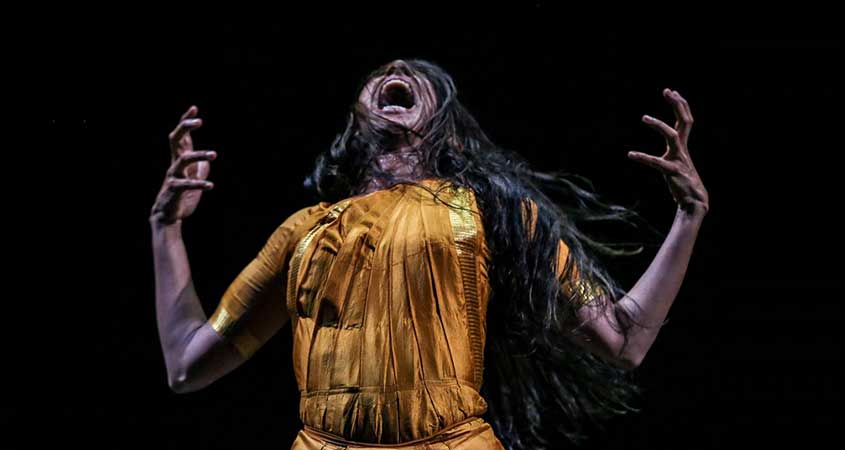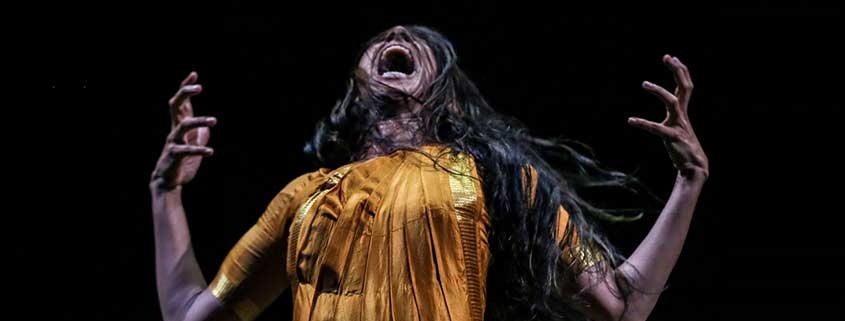She’s Auspicious 2021 – Refinement
When I was younger learning dance, I had this obsession with my movements being “perfect.” My turnout is physiologically not great, I don’t have long arms, I’m not naturally flexible. Overall I never had the “body of a dancer.”
And what’s most interesting to me now, is that this image of the “perfect dancing body” was not imposed on me by my mother/dance teacher. Of course, she’d incessantly correct my araimandi – (sitting posture), and positions of my arms, legs, feet etc, but her focus was always more on energy and emotion, than perfection of execution.
From a young age, I remember this confusion that I held within me: I wanted to dance with the speed, passion, and immersion that I saw in my mom when she danced, but I also wanted to look “perfect,” which she didn’t always. (so much so that I went through a pretty long phase that lasted 3-4 years, where I was so stiff – in attempting to be neat and “perfect” – that I barely moved my head when I danced.) I had a few role-models outside of our school who were young star performers with perfect technique, but some of my favorite of the senior dancers in my mom’s school were the ones whose dancing was quirky, passionate, and full of character.
And though I loved it on them, I didn’t appreciate those qualities in myself. For the longest time (until not too long ago actually) I hated my own dancing. My quirks were flaws that stood in the way of this image of perfection that I held in my mind. An image I had held since childhood and never let go. Where did those ideals come from?
Though it was not the style of dance I grew up around, I felt drawn to the Kalakshetra style – how they looked “organized” and “neat” and all so uniform when they dance in a group. I always saw that as a problem in Shakti – how no two dancers danced alike, and so a group never had that “perfect” look. (Now I realize the value in that “imperfection”!)
The thing I loved most about my mom’s dancing, was her ability to inhabit a character. I would sit through her solo 5 hour (I’m not joking) Ramayana dance drama, taking in all the characters from Ravana to Shabari, to Sita, Kaikeyi, Hanuman, journeying through the fascinating and emotional journey of the Ramayana through her. Dozens of scenes clearly etched in my mind and heart even three decades later.
And yet I remember the embarrassment I felt at a moment watching her execute a scene of final battle between Duryodhana and Bhima, where she got so intense as Bhima that she stomped her feet in ways that I never imagined “appropriate” for a Bharata Natyam dancer. I still remember the way she threw her mace on the ground, and the embarrassment that I felt because I felt she was being “out of line.” That her actions came out of her rage in that moment as Bhima – defending the assault on his wife and the atrocities committed towards his family, and all the emotional baggage he had carried with him since childhood – didn’t matter to me. To me, she had crossed an aesthetic line, and it embarrassed me to see her express that kind of rage….. especially while in her Bharata Natyam finery.
I remember feeling that same embarrassment as an 8-year-old watching a performance video of myself playing young Arjuna, in which I made a victorious gesture saying to Drona (Arjuna’s Guru in archery), “Make me the best!” When I watched that moment later as an adult, I thought it was excellent – passionate, hungry, and exuberant as young Arjuna would have been. But I remember watching the replay of that moment shortly after the performance, and feeling that my gesture was too emphatic and involved– disapproving of my lack of refinement.
Now as I question these notions of “refinement” and these “crossed lines” – what is appropriate and what is not – I am taken back to those moments of embarrassment. Where did those feelings come from? They were surely not imparted by mom, who cares much less for perfection than for passion, energy, and involvement.
I remember when I started spending long periods in India for the first time in 2005, I was besotted with dancers who were beautiful as they danced (“its like watching models dancing” – my husband once remarked years later). I remember enjoying their beauty as they danced – the beauty and perfection of physical lines in space, yes but also the way they performed their beauty. It was so fascinating to me.
The idea of being “beautiful” when you dance had never been a “thing.” My mom was an insanely gorgeous woman but it was never her “beauty” that struck me when I saw her dance. In fact, in our school, even though we’d remark that “so and so looks beautiful in costume, or it suits her etc etc,” it was never that person’s “beauty” that came to the fore while dancing. We smiled when we danced yes, because we’d been taught to – {“smile!!”} and also sometimes because we were enjoying ourselves. But never [I don’t think] with the intention of expressing beauty.
But the way these dancers smiled was curated, detailed, deliberate, interwoven with the movement.
I was entranced by it.
Now, suddenly it makes me uncomfortable.
But also now – ask me to dance a jathi or a thillana, or a swaram – I’ll smile my way through it – because I’m enjoying the movement, the music, the rhythm, the play of the choreography. But also, now I don’t know if that’s organic or conditioned. I can’t do it without the smile, because that feels forced and inauthentic. What is natural??
I watch videos of Balaswaraswathi (she’s our reference in many ways for a way of dancing that we are grasping to hold onto and learn about) dance a a jathi. She is rarely smiling. Sometimes it actually reminds of the children in class who are dancing, and unsure of whether or not they are happy to be there or dancing because their parents want them to. Or maybe they are just deep in concentration.
But it makes me wonder? Do we have to be smiling through – to show our enjoyment?
When did smiling in dance become a thing? Does it come from upper-class Western ideals of performance? Have ballerinas always smiled?
We see it in super-star movie star dancers who performed Bharatanatyam in films. Is that when the smiling started? No photos that I have seen of Devadasis and Isai Vellalar women show them smiling. Was smiling a part of Sathir? Did dancers in the courts smile?
When did the rules of involvement (smiling, weeping, etc.) get solidified into the practice? (don’t point me to a text or theory! I want to know in PRACTICE!)
My mom would weep and shake as an enraged Panchali, but her Nattuvanar Gurus never told her that that was crossing a line.
As I play with my own thresholds in She’s Auspicious, I can’t help but go back to my 8-year old self and wonder if she would be cringing….

Pic credit- Michel Cavalca



